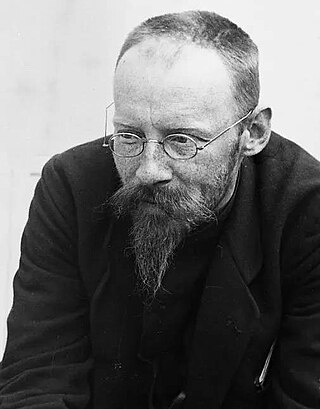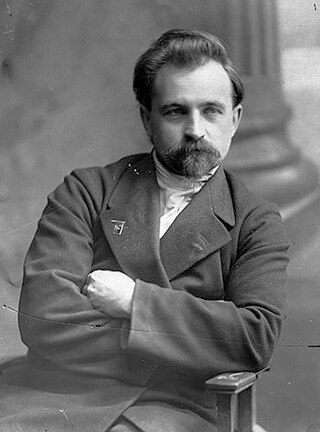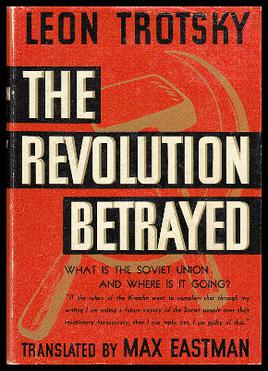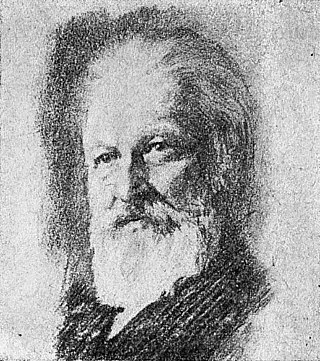
Lev Davidovich Bronstein, better known as "Leon Trotsky", was a Russian revolutionary, politician, and political theorist. He was a central figure in the 1905 Revolution, October Revolution, Russian Civil War, and establishment of the Soviet Union. Trotsky and Vladimir Lenin were widely considered the two most prominent Soviet figures, and Trotsky was "de facto" second-in-command during the early years of the Russian Soviet Republic. Ideologically a Marxist and Leninist, his thought and writings inspired a school of Marxism known as Trotskyism.

The October Revolution, also known as the Great October Socialist Revolution, October coup, Bolshevik coup, or Bolshevik revolution, was a revolution in Russia led by the Bolshevik Party of Vladimir Lenin that was a key moment in the larger Russian Revolution of 1917–1923. It was the second revolutionary change of government in Russia in 1917. It took place through an insurrection in Petrograd on 7 November 1917 [O.S. 25 October]. It was the precipitating event of the Russian Civil War. The initial stage of the October Revolution which involved the assault on Petrograd occurred largely without any human casualties.

Stalinism is the totalitarian means of governing and Marxist–Leninist policies implemented in the Soviet Union (USSR) from 1927 to 1953 by dictator Joseph Stalin and in Soviet satellite states between 1944 and 1953. Stalin had previously made a career as a gangster and robber, working to fund revolutionary activities, before eventually becoming General Secretary of the Soviet Union. Stalinism included the creation of a one man totalitarian police state, rapid industrialization, the theory of socialism in one country, forced collectivization of agriculture, intensification of class conflict, a cult of personality, and subordination of the interests of foreign communist parties to those of the Communist Party of the Soviet Union, which Stalinism deemed the leading vanguard party of communist revolution at the time. After Stalin's death and the Khrushchev Thaw, a period of de-Stalinization began in the 1950s and 1960s, which caused the influence of Stalin's ideology to begin to wane in the USSR.

Trotskyism is the political ideology and branch of Marxism developed by Russian revolutionary and intellectual Leon Trotsky along with some other members of the Left Opposition and the Fourth International. Trotsky described himself as an orthodox Marxist, a revolutionary Marxist, and a Bolshevik–Leninist as well as a follower of Karl Marx, Frederick Engels, Vladimir Lenin, Karl Liebknecht, and Rosa Luxemburg. His relations with Lenin have been a source of intense historical debate. However, on balance, scholarly opinion among a range of prominent historians and political scientists such as E.H. Carr, Isaac Deutscher, Moshe Lewin, Ronald Suny, Richard B. Day and W. Bruce Lincoln was that Lenin’s desired “heir” would have been a collective responsibility in which Trotsky was placed in "an important role and within which Stalin would be dramatically demoted ".

The Great Purge, or the Great Terror, also known as the Year of '37 and the Yezhovshchina, was a political purge in the Soviet Union that took place from 1936 and 1938. It sought to consolidate Joseph Stalin's power over the Communist Party of the Soviet Union and aimed at removing the remaining influence of Leon Trotsky within the Soviet Union. The term great purge was popularized by the historian Robert Conquest in his 1968 book The Great Terror, whose title was an allusion to the French Revolution's Reign of Terror.

Nadezhda Konstantinovna Krupskaya was a Russian revolutionary and the wife of Vladimir Lenin.

Nikolay Nikolayevich Krestinsky was a Soviet Bolshevik revolutionary and politician who served as the Responsible Secretary of the Communist Party of the Soviet Union.

Jukums Vācietis was a Latvian and Soviet military commander. He was a rare example of a notable Soviet leader who was not a member of the Communist Party, until his demise during the Great Purge in the 1930s.

Censorship in the Soviet Union was pervasive and strictly enforced.

Ivar Tenisovich Smilga was a Latvian Bolshevik leader, Soviet politician and economist. He was a member of the Left Opposition in the Soviet Union.

Georgy (Yury) Leonidovich Pyatakov was a Ukrainian revolutionary and Bolshevik leader, and a key Soviet politician during and after the 1917 Russian Revolution. Pyatakov was considered by contemporaries to be one of the early communist state's best economic administrators, but with poor political judgement.
Soviet historiography is the methodology of history studies by historians in the Soviet Union (USSR). In the USSR, the study of history was marked by restrictions imposed by the Communist Party of the Soviet Union (CPSU). Soviet historiography is itself the subject of modern studies.
David King was a British graphic designer, design historian, and writer, who assembled one of the largest collections of Soviet graphics and photographs. From this collection, he created a series of books covering the history of the Russian Revolution and its associated art and propaganda. In addition to Soviet-era photographs, posters, and other materials, his collection included items related to the Spanish Civil War, Maoist China, the Weimar Republic, and American labour organizations. King, a "leftist with Trotskyist leanings", in particular collected photographs and ephemera related to Leon Trotsky, who was extensively doctored out of revolutionary photographs and records under Josef Stalin's regime.

Yevgeni Alekseyevich Preobrazhensky was a Russian revolutionary, Soviet economist and sociologist. A member of the governing Central Committee of the Bolshevik faction and its successor, the All-Union Communist Party, Preobrazhensky is remembered as a leading voice for the rapid industrialisation of peasant Russia through a concentration on state-owned heavy industry.

Karl Berngardovich Radek was a revolutionary and writer active in the Polish and German social democratic movements before World War I and a Communist International leader in the Soviet Union after the Russian Revolution.

Lessons of October is a polemical essay of about 60 printed pages in length by Leon Trotsky, first published in Moscow in October 1924 as the preface to the third volume of his Collected Works. The essay was harshly critical of the purported revolutionary failings of Grigory Zinoviev and Lev Kamenev, two key members of the collective leadership which briefly ruled Soviet Russia in the months after the death of V. I. Lenin. Publication of the essay was used as a pretext for the Soviet leadership to isolate and attack Trotsky, whom the leadership mutually perceived as a threat to accede to supreme power.

The Revolution Betrayed: What is the Soviet Union and Where is it Going? is a book published in 1936 by the exiled Soviet leader Leon Trotsky. This work analyzed and criticized the course of historical development in the Soviet Union following the death of Vladimir Lenin in 1924 and is regarded as Trotsky's primary work dealing with the nature of Stalinism. The book was written by Trotsky during his exile in Norway and was originally translated into Spanish by Victor Serge. The most widely available English translation is by Max Eastman.

The following is a chronological list of books by Leon Trotsky, a Marxist theoretician, including hardcover and paperback books and pamphlets published during his life and posthumously during the years immediately following his assassination in the northern summer of 1940. Included are the original Russian or German language titles and publication information, as well as the name and publication information of the first English language edition.

Mikhail Stepanovich Olminsky was a prominent Russian Bolshevik particularly involved with Party history and also an active literary theorist and publicist.

Stalin: An Appraisal of the Man and His Influence is a political biography of Joseph Stalin, written by Leon Trotsky between 1938 and 1940. The book was never finished due to Trotsky's assassination in August 1940 although copious draft manuscripts for concluding chapters survived, allowing editors to complete the work.




















